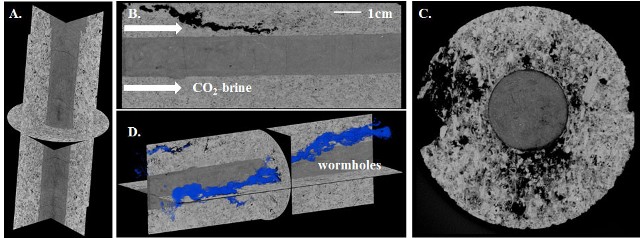Feb 12 2016
When carbon dioxide is stored underground in a process known as geological sequestration, it can find multiple escape pathways due to chemical reactions between carbon dioxide, water, rocks and cement from abandoned wells, according to Penn State researchers.
 (A) is a cross-section of a limestone/cement sample before the experiment. (B) shows dissolving in the limestone but not the cement (at the center of the image). (C) is a sandstone/cement sample, indicating that the sandstone remained intact when contacting carbon-dioxide-infused saltwater, and the cement at the core of the sample began to dissolve. (D) shows the pathways created in the limestone from the experiment. (Image: Zuleima Karpyn / Penn State)
(A) is a cross-section of a limestone/cement sample before the experiment. (B) shows dissolving in the limestone but not the cement (at the center of the image). (C) is a sandstone/cement sample, indicating that the sandstone remained intact when contacting carbon-dioxide-infused saltwater, and the cement at the core of the sample began to dissolve. (D) shows the pathways created in the limestone from the experiment. (Image: Zuleima Karpyn / Penn State)
The researchers investigated the properties of porous rocks into which carbon dioxide is injected. These rocks, known as host rocks, function like containers for the carbon dioxide. The team looked at two abundant host rocks, limestone and sandstone, which have different chemical properties.
"We were interested in examining these rocks because they are widely found underground, but there have been concerns that carbon dioxide may escape once it's injected underground," said Li Li, associate professor of petroleum and natural gas engineering. "Even if it doesn't escape to the Earth's surface, there are concerns that it may leak into groundwater drinking aquifers."
In addition to encountering host rocks, carbon dioxide stored underground may also contact and dissolve into saltwater deposits. When this happens, the carbon dioxide increases the acidity of the saltwater. The high-acidity saltwater-carbon dioxide mixture can dissolve certain types of rocks, such as limestone, as well as cement casings on abandoned oil and gas wells.
"If this plume of carbon dioxide-saturated brine reaches an abandoned well, it will react with the cement," said Zuleima Karpyn, associate professor of petroleum and natural gas engineering and Quentin E. and Louise L. Wood Faculty Fellow in Petroleum and Natural Gas Engineering. "This may open up cracks in the cement depending on the conditions, which would increase the likelihood of carbon dioxide escaping. We were trying to assess what would happen in the process if the host rock itself were to react with the carbon dioxide-saltwater mixture."
To recreate natural settings, the researchers conducted an experiment by flowing carbon-dioxide-rich saltwater into two different systems -- cement embedded in a sandstone host rock, and cement embedded in limestone. They monitored the chemical reactions that took place and measured changes occurring in the host rocks and cement. Their findings, published in the current issue of the International Journal of Greenhouse Gas Control, indicate that the host rocks can create different types of escape pathways.
The saltwater-carbon dioxide solution dissolved parts of the limestone, which lowered the acidity of the solution. In eight days, the limestone lost 3 percent of its mass and became 24 times more permeable than at the start of the reaction, which means liquids and gases can move through it much easier. The carbon dioxide-saltwater liquid also became less acidic in the dissolution process. As a result, it did not dissolve any of the cement.
"In the limestone interactions, the rock itself becomes the dominant medium for the dissolution reaction while the cement was the secondary reactant," said Karpyn. "This means that wellbores are more likely to stay intact if you have limestone. But dissolving the limestone can create leakage pathways, for example, by forming finger-like channels of dissolved rock."
The researchers found the opposite to be true for the sandstone sample. Rather than dissolving the sandstone, the solution degraded the cement. The sandstone lost very little mass, and the cement lost mass and became more porous.
These findings highlight the complexity of underground carbon sequestration, which is a process under investigation as a method to reduce carbon dioxide levels in the atmosphere.
"The process of assessing whether a site is appropriate for injection has to be system-specific and take into account not only the chemistry and composition of the rocks, but also the ease with which water and carbon dioxide can flow through host rocks," said Li.
Peilin Cao, Penn State Ph.D. student, collaborated on this research.
Penn State, the Quentin E. and Louise L. Wood Endowed Faculty Fellowship and the U.S. Department of Energy supported this work.